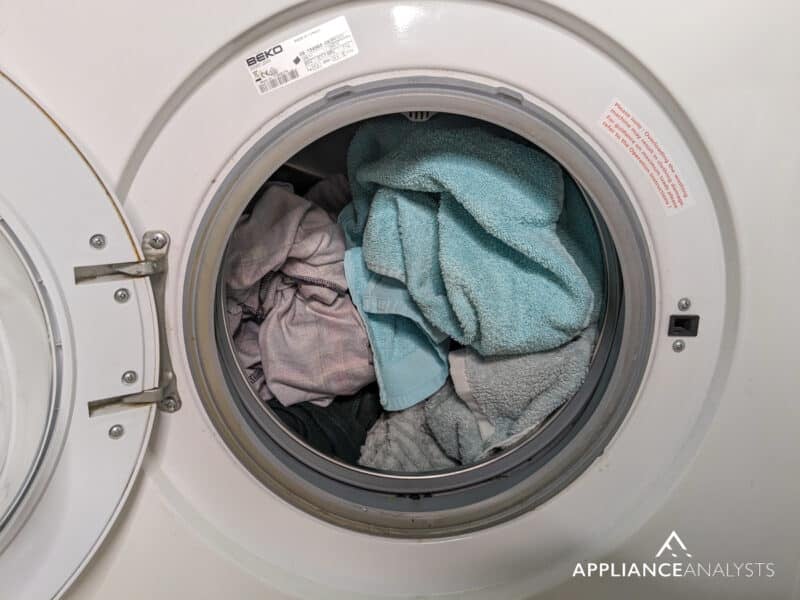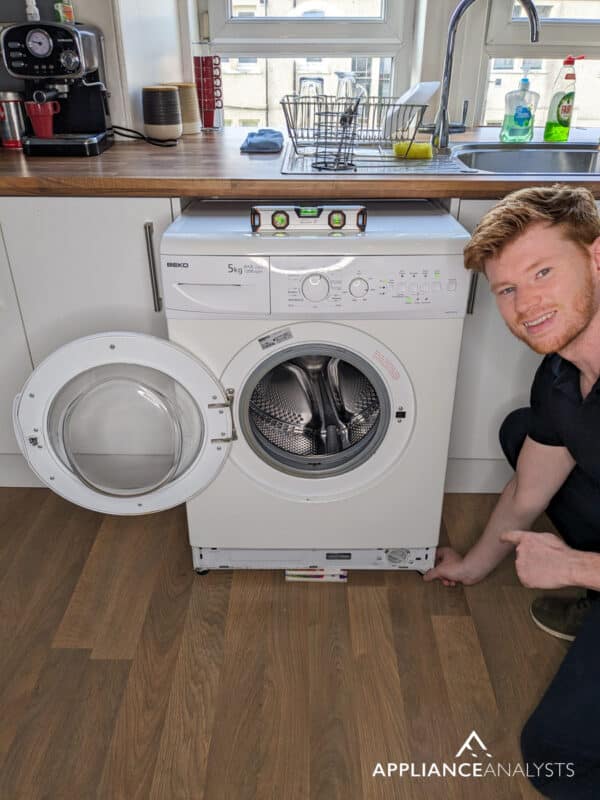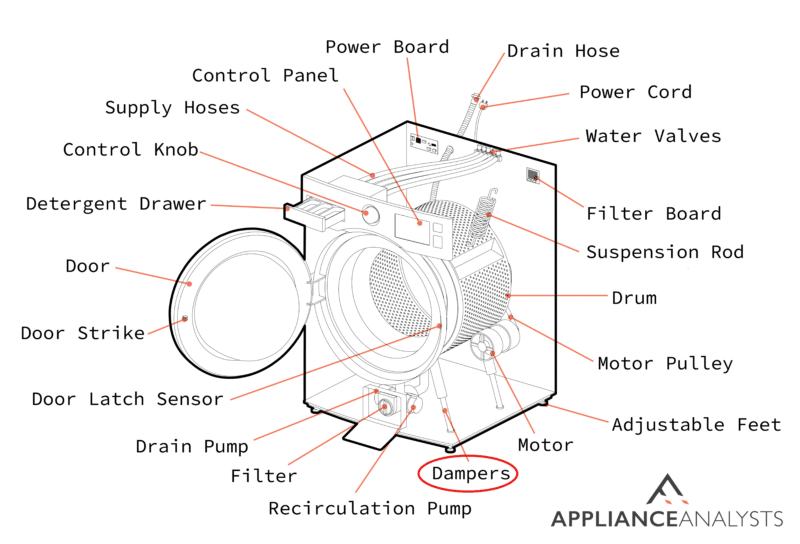We've independently reviewed this article to make sure it's as accurate as we can make it.
To find out more about our article creation and review process, check out our editorial guidelines.
Is your washing machine shaking?
It is common for washing machines to experience some shaking, especially when handling larger loads. However, if you notice excessive shaking, it can indicate a malfunction in certain internal components.
Don’t worry, though. I’m here to help.
If your washing machine is shaking, check your laundry load, level the unit, and test your floor’s stability. If the issue persists, check for loose components and inspect the suspension rods, dampers, or balance weights.
Read on to learn how to keep your washer from shaking excessively!
How to Stop Your Washing Machine from Shaking Too Much: 5 Tips
While it’s common for washers to shake and vibrate during the spin cycle, excessive shaking can indicate an underlying issue.
In this section, I’ll guide you through the different solutions you can try to fix the excessive shaking in your washing machine.
Are you ready? Let’s dive in!
#1 Check Your Laundry Load
When I see a washing machine shaking a lot, I always check the laundry load.
You see, overloading the drum can cause an imbalance during the spin cycle, putting extra strain on both the motor and suspension system. As a result, your washer will start shaking and vibrating.
The easiest way to solve the shaking issue is by simply rearranging your laundry so that the weight is more evenly distributed. Don’t have all the heavy items on one side and all the light ones on the other.

It’s also crucial to aim to fill your washing machine to 75% of its capacity to prevent overloading and ensure the best cleaning results. I also recommend reading the manufacturer’s manual, which typically includes capacity guidelines and tips to load your specific washer correctly.
Tip: If you have to wash a small load and are concerned about the balance, consider adding a few towels.
#2 Level Your Washing Machine
My usual advice to prevent excessive shaking in a washing machine is to ensure the unit is level.
If your washer is not level, the weight inside the drum will not be evenly distributed. As a result, you’ll notice excessive shaking, noise, and vibration during the spin cycle.
Don’t worry, though. In my opinion, leveling a washing machine is very simple. You’ll just need to:
- Empty your washing machine and unplug it from the wall outlet to prevent any electrical hazards.
- Use a spirit level to check if your washer is level from side to side and front to back.
- If the bubble isn’t centered, access the adjustable feet at the front or rear corners under the washer. If necessary, ask a friend for help to move your washer.
- Turn the leveling feet counterclockwise to lower that corner of the washer or clockwise to raise it. You can use a wrench or pliers. I recommend adjusting the back feet first.
- Make small adjustments to the leveling feet until they touch the floor, and the bubble in the spirit level is centered.
- Most washers have a locking nut above the rubber feet. Please make sure to tighten it after leveling.
- Plug your washer back into the power outlet and load it. During the spinning cycle, check the feet and make sure they’re touching the ground. If you notice the feet are momentarily lifted off the ground, adjust the feet as the washer is shaking.

Leveling your washer will help prevent excessive shaking, improve the wash performance, and extend the unit’s life span.
#3 Test the Floor’s Stability
In my experience, the type of floor in your laundry room can determine how much your washer shakes.
You can test your floor’s stability by jumping in the room. Check if the objects on the shelves shake. If they do, the floor is probably the reason why your washer is shaking.
I find that concrete floors offer the best stability for washing machines. Pier and beam floors, commonly found in older homes, have less stability.
You can use anti-vibration pads under your washing machine to keep it from shaking, minimize noise, and isolate vibration. If the issue persists, consider moving your washer to a room with a concrete (or more stable) floor.
#4 Check For Loose Parts
I’ve seen that loose parts inside a washer can also contribute to excessive shaking and vibration.
You see, loose parts can lead to unstable drum movement, causing an imbalance during the spin cycle. Loose components can also create noise, making the shaking seem even worse.
To solve the issue, you’ll need to identify which parts are loose and tighten them. Here’s how to do it:
- Unplug your washing machine from the wall outlet to prevent electrical hazards.
- Inspect the exterior panel and tighten any loose screws.
- Remove the back or bottom panel to access the internal components.
- Now that you have a clear view of your washer’s internal components, please check for anything loose and tighten any screws that could use a couple more turns.
- While you’re at it, please inspect the drive belt. If it appears loose or damaged, replace it with a new one.
- If nothing’s loose, then the source of the excessive shaking is likely coming from the suspension mechanism. Please reassemble the washer and follow the next step.

#5 Examine the Suspension System
If you’ve tried all the fixes above, but your washing machine is still shaking excessively, there’s probably an issue with the suspension system.
Washers have a suspension system consisting of suspension rods, shocks, balance weights, or other components designed to absorb vibrations. If there’s an issue with one of the components in the suspension system, your machine will shake more than normal.
Top loaders are suspended by four suspension rods, which are basically a piece of metal found in each corner of the washer, connecting the drum to the machine’s frame. When the rods begin to fail, they no longer effectively mitigate the washer’s movement.

So, if you have a top-loading washing machine, test the effectiveness of the suspension rods by pushing down on the empty washing tub. If it bounces more than once, it indicates that the rods need to be replaced.
Front loaders, on the other hand, have shocks or dampers typically found near the bottom of the machine, connecting the drum to the frame. They also have balance weights that help distribute the weight of the drum.

If you have a front-loading washer, I recommend checking the balance weights, which are basically blocks of concrete mounted to the drum. Tighten them if they’re loose. Don’t forget to replace the shocks if they’re loose or damaged.
Note: Some modern washers have a calibration mode that can reset the internal balancing mechanism. Please check your manual to see if your model supports the calibration mode.
Keep in mind that if you’re not comfortable checking the suspension system yourself, it’s best to call a professional.
Conclusion
Hopefully, now you know how to fix your washer’s shaking issues.
Remember that if your washing machine is shaking excessively, you’ll need to avoid overloading the drum and evenly arrange your clothes to distribute the weight. It’s also important to level your washing machine and adjust the feet.
Don’t forget to test the floor’s stability, check for any loose components, and inspect the suspension rods, dampers, and balance weights.
Thank you so much for taking the time to read this article. If you ever experience a different issue while using your washer, please check out our site. You’ll find multiple guides that will help you fix it.
Have a wonderful rest of the day!








